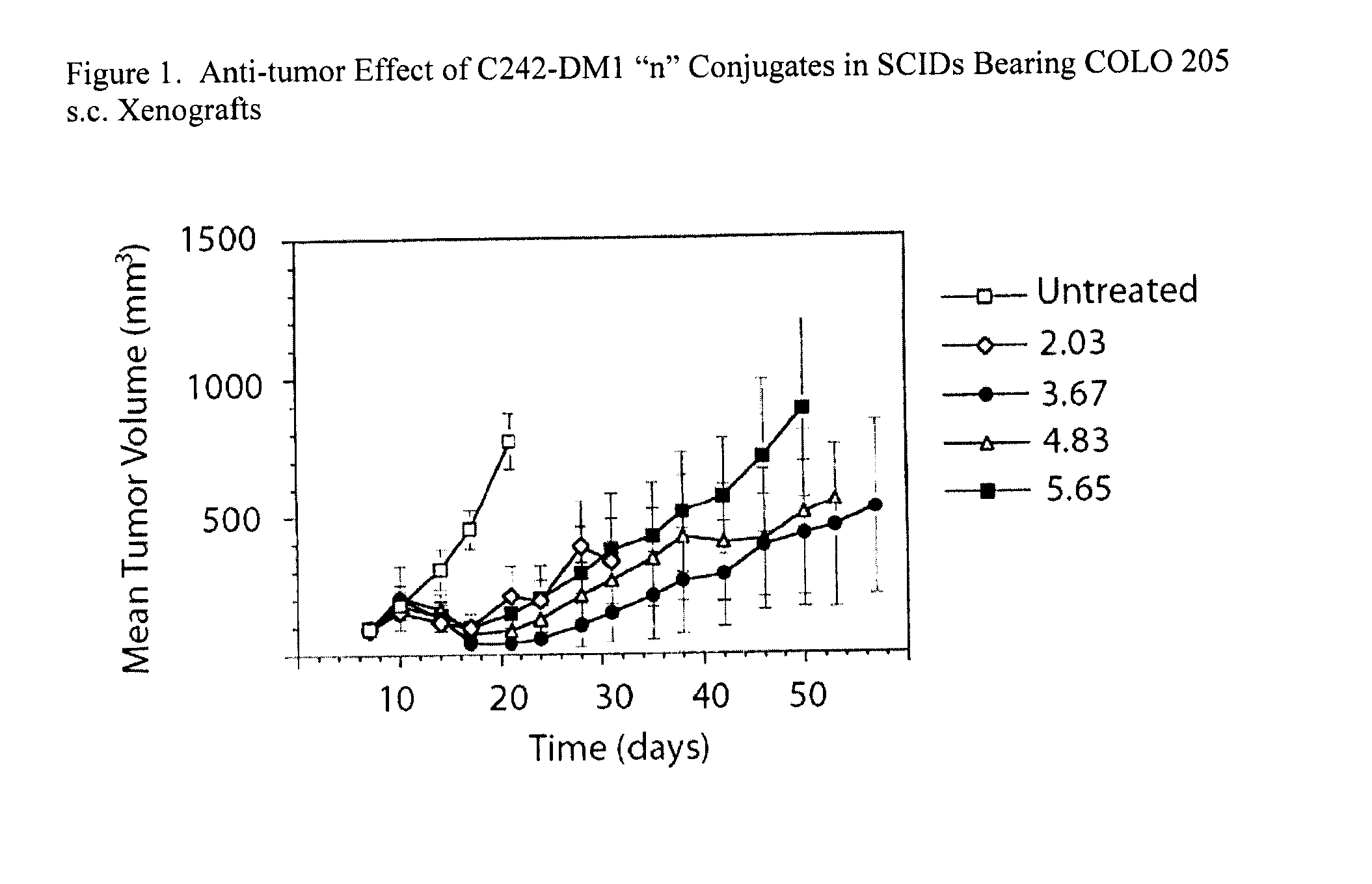Potent cell-binding agent drug conjugates
a cell-binding agent and conjugate technology, applied in the direction of drug compositions, antibody medical ingredients, peptides, etc., can solve the problems of inability to deliver a sufficient concentration of drugs to the target site, modified antibodies often display impaired binding to the target antigen, and inability to fast in vivo clearance from the blood stream
- Summary
- Abstract
- Description
- Claims
- Application Information
AI Technical Summary
Problems solved by technology
Method used
Image
Examples
example 1
Preparation of C242-DM1 Conjugates Bearing Different Maytansinoid Loads
Materials and Methods:
[0091]Forty-four female CB.17 SCID mice (Dept. of Radiation Oncology, Massachusetts General Hospital, Boston, Mass.) were inoculated with 2×106 Colo 205 (ATCC CRL 222) cells in 0.1 mL RPMI under the skin of their right flank. When tumors reached 50-100 mm3, seven days later, mice were identified using Sharpie markers, and randomized based upon tumor size into five groups (n=7 / group). Groups of mice were then treated as follows:
[0092]1. Untreated control
[0093]2. 75 μg / kg / day C242-DM12.03 (1304−196)×5 qd, I.V.
[0094]3. 75 μg / kg / day C242-DM13.67 (1304−184)×5 qd, I.V.
[0095]4. 75 μg / kg / day C242-D.M14.83 (1304−195)×5 qd, I.V.
[0096]5. 75 μg / kg / day C242-DM15.65 (1304−172)×5 qd, I.V.
[0097]All dose formulations were made on each day of dosing using sterile phosphate buffered saline (PBS) as the diluent. Mice were dosed based upon their individual day 7 weight by varying the volume of injection. Tumor v...
example 2
Preparation of HUN901-DM1 Conjugates Bearing Different Maytansinoid Loads
[0099]In the first step, the huN901 antibody was reacted with the modifying agent 4-[2-pyridyldithio]pentanoic acid-N-hydroxysuccinimde ester (SPP) to introduce dithiopyridyl groups. A solution of huN901 antibody was diluted to 8 mg / mL in an aqueous buffer containing 0.05 M potassium phosphate, 0.05 M sodium chloride and 2 mM ethylenediaminetetra-acetic acid (EDTA), pH 6.5 and was reacted with SPP molar excesses ranging from 2 equivalents to 15 equivalents in dimethylacetamide (DMA), such that the reaction mixture was 5% DMA total. The reaction mixture was stirred at room temperature for 90 min and purified over a Sephadex G25 pre-packed column (NAP25) that had been previously equilibrated into the aforementioned buffer. The molar ratio of released SPy per mole of antibody was calculated by measuring the A280 of the sample and then the increase in the A343 of the sample after adding dithiothreitol (DTT) (0.05 m...
example 3
Binding Studies
[0103]Binding of the huN901 antibody and its DM1 conjugates was evaluated on whole cells by an indirect immunofluorescence assay utilizing flow cytometry. Cells (5×104 per well) were plated in a round bottom 96-well plate (Falcon #2072) and incubated at 4° C. for 3 hours with serial dilutions of huN901 antibody or huN901-SPP-DM1 in 0.2 mL of alpha-MEM medium (Invitrogen, Inc.) supplemented with 2% (v / v) normal goat serum (Sigma). Each sample was run in duplicate. Control wells contained cells and the medium, but lacked the antibody or the conjugates. The cells were then washed with 0.2 mL cold (4° C.) medium and stained with fluorescein-labeled goat anti-human IgG antibody at 4° C. for 50 min. The cells were again washed with the medium, fixed in 1% formaldehyde / PBS solution and then analyzed using a FACSCalibur flow cytometer (BD Biosciences, San Jose, Calif.). Apparent Kd values were determined by curve fitting analysis using Prism software.
[0104]The results are sho...
PUM
| Property | Measurement | Unit |
|---|---|---|
| Electrical resistance | aaaaa | aaaaa |
| Chemotherapeutic properties | aaaaa | aaaaa |
Abstract
Description
Claims
Application Information
 Login to View More
Login to View More - R&D
- Intellectual Property
- Life Sciences
- Materials
- Tech Scout
- Unparalleled Data Quality
- Higher Quality Content
- 60% Fewer Hallucinations
Browse by: Latest US Patents, China's latest patents, Technical Efficacy Thesaurus, Application Domain, Technology Topic, Popular Technical Reports.
© 2025 PatSnap. All rights reserved.Legal|Privacy policy|Modern Slavery Act Transparency Statement|Sitemap|About US| Contact US: help@patsnap.com



